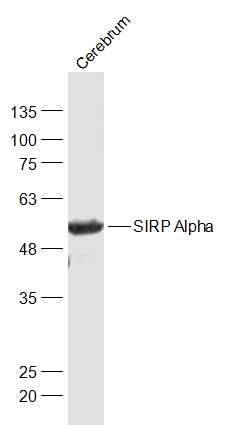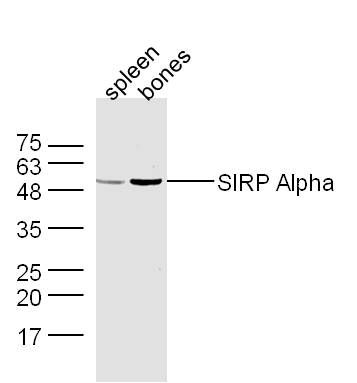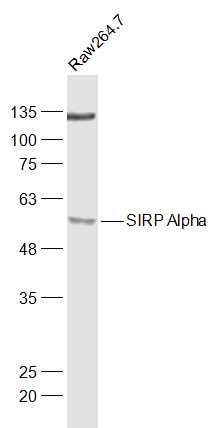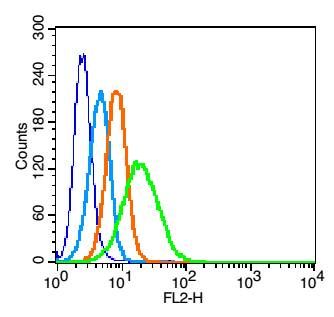信号调节蛋白α抗体
产品名称: 信号调节蛋白α抗体
英文名称: SIRP Alpha
产品编号: 2708
产品价格: null
产品产地: 上海
品牌商标: 雅吉
更新时间: null
使用范围: WB ELISA Flow-Cyt
上海雅吉生物科技有限公司
- 联系人 :
- 地址 : 上海市闵行区元江路5500号第1幢5658室
- 邮编 :
- 所在区域 : 上海
- 电话 : 158****3937 点击查看
- 传真 : 点击查看
- 邮箱 : yajikit@163.com
| 中文名称 | 信号调节蛋白α抗体 |
| 别 名 | Signal regulatory protein alpha type 1; BIT; Brain Ig like molecule with tyrosine based activation motifs; Brain immunoglobulin like molecule with tyrosine based activation motifs; CD172 antigen like family member A; CD172a; CD172a antigen; Inhibitory receptor SHPS1; Macrophage fusion receptor; MFR; MYD 1; Myd 1; MYD1; p84;Protein tyrosine phosphatase non receptor type substrate 1; PTPNS1; SHP Substrate 1; SHPS1; Signal regulatory protein alpha 2; Signal regulatory protein alpha 3; Signal regulatory protein alpha; Signal Regulatory Protein Alpha Type 1; Signal regulatory protein alpha type 2; SIRP; SIRPA; SIRPalpha; SIRPalpha1; SIRPalpha2; SIRPalpha3; Tyrosine phosphatase SHP substrate 1; Tyrosine protein phosphatase non receptor type substrate 1; Tyrosine protein phosphatase non receptor type substrate; CD172a. |
| 研究领域 | 神经生物学 |
| 抗体来源 | Rabbit |
| 克隆类型 | Polyclonal |
| 交叉反应 | Human, Mouse, (predicted: Rat, Dog, Pig, Cow, Horse, ) |
| 产品应用 | WB=1:500-2000 ELISA=1:500-1000 Flow-Cyt=1μg /test not yet tested in other applications. optimal dilutions/concentrations should be determined by the end user. |
| 分 子 量 | 56kDa |
| 细胞定位 | 细胞膜 |
| 性 状 | Liquid |
| 浓 度 | 1mg/ml |
| 免 疫 原 | KLH conjugated synthetic peptide derived from human CD172a:151-250/504 |
| 亚 型 | IgG |
| 纯化方法 | affinity purified by Protein A |
| 储 存 液 | 0.01M TBS(pH7.4) with 1% BSA, 0.03% Proclin300 and 50% Glycerol. |
| 保存条件 | Shipped at 4℃. Store at -20 °C for one year. Avoid repeated freeze/thaw cycles. |
| PubMed | PubMed |
| 产品介绍 | Protein tyrosine phosphatases (PTPases) SHP1 and SHP2 are critical regulators in the intracellular signaling pathways that result in cell responses such as mitosis, differentiation, migration, survival, transformation or death. SHP2 is a signal transducer for several receptor tyrosine kinases and cytokine receptors. A novel SHP2 associated glycoprotein was recently cloned from human, rat, mouse and cattle by several labs and was designated SIRPa (1),SHPS1 , MyD1, BIT and p84. SIRPa is a new gene family containing at least fifteen members. SIRPa is a substrate of many activated tyrosine kinases such as insulin receptor, EGFR, PDGFR and src, and a specific docking protein for SHP2. SIRPa has regulatory effects on cellular responses induced by serum, growth factors, insulin, oncogenes, growth hormones and cell adhesion and plays a general role in different physiological and pathological processes. Function: Immunoglobulin-like cell surface receptor for CD47. Acts as docking protein and induces translocation of PTPN6, PTPN11 and other binding partners from the cytosol to the plasma membrane. Supports adhesion of cerebellar neurons, neurite outgrowth and glial cell attachment. May play a key role in intracellular signaling during synaptogenesis and in synaptic function (By similarity). Involved in the negative regulation of receptor tyrosine kinase-coupled cellular responses induced by cell adhesion, growth factors or insulin. Mediates negative regulation of phagocytosis, mast cell activation and dendritic cell activation. CD47 binding prevents maturation of immature dendritic cells and inhibits cytokine production by mature dendritic cells. Subunit: Binds PTPN11 when tyrosine-phosphorylated, except in macrophages, where it primarily binds PTPN6. Binds GRB2 in vitro. Binds FGR (By similarity). Binds JAK2 irrespective of its phosphorylation status and forms a stable complex. Binds SCAP1 and/or SCAP2. The resulting complex recruits FYB. Binds PTK2B. Subcellular Location: Membrane; Single-pass type I membraneprotein. Tissue Specificity: Ubiquitous. Highly expressed in brain. Detected on myeloid cells, but not T-cells. Detected at lower levels in heart, placenta, lung, testis, ovary, colon, liver, small intestine, prostate, spleen, kidney, skeletal muscle and pancreas. Post-translational modifications: N-glycosylated. Phosphorylated on tyrosine residues in response to stimulation with EGF, growth hormone, insulin and PDGF. Dephosphorylated by PTPN11. Similarity: Contains 2 Ig-like C1-type (immunoglobulin-like) domains. Contains 1 Ig-like V-type (immunoglobulin-like) domain. SWISS: P78324 Gene ID: 140885 Database links: Entrez Gene: 140885 Human Entrez Gene: 19261 Mouse Entrez Gene: 25528 Rat Omim: 602461 Human SwissProt: P78324 Human SwissProt: P97797 Mouse SwissProt: P97710 Rat Unigene: 581021 Human Unigene: 1682 Mouse Unigene: 53971 Rat Important Note: This product as supplied is intended for research use only, not for use in human, therapeutic or diagnostic applications. |
| 产品图片 |  Sample: Sample:Cerebrum (Mouse) Lysate at 40 ug Primary: Anti-SIRP Alpha (bs-2708R) at 1/1000 dilution Secondary: IRDye800CW Goat Anti-Rabbit IgG at 1/20000 dilution Predicted band size: 56 kD Observed band size: 56 kD  Sample: Sample:Spleen(Mouse) Lysate at 30 ug Bones (Mouse) Lysate at 30 ug Primary: Anti- SIRP Alpha (bs-2708) at 1/300 dilution Secondary: IRDye800CW Goat Anti-Rabbit IgG at 1/20000 dilution Predicted band size: 56 kD Observed band size: 53 kD  Sample: Sample:Raw264.7(Mouse) Cell Lysate at 30 ug Primary: Anti-SIRP Alpha (bs-2708R) at 1/1000 dilution Secondary: IRDye800CW Goat Anti-Rabbit IgG at 1/20000 dilution Predicted band size: 56 kD Observed band size: 56 kD  Blank control(blue): U937 (fixed with 2% paraformaldehyde (10 min)). Blank control(blue): U937 (fixed with 2% paraformaldehyde (10 min)).Primary Antibody:Rabbit Anti- SIRP antibody(bs-2708R), Dilution: 1μg in 100 μL 1X PBS containing 0.5% BSA; Isotype Control Antibody: Rabbit IgG(orange) ,used under the same conditions ); Secondary Antibody: Goat anti-rabbit IgG-PE(white blue), Dilution: 1:200 in 1 X PBS containing 0.5% BSA. |
